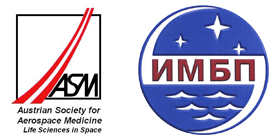In space, man and materials are exposed to particle radiation as well as electromagnetic ionizing radiation. The radiation affects on the material depends on the one hand, the total amount of energy absorbed, and on the other hand, the linear transfer of energy. This Linear Energy Transfer (LET) supplies information of how much energy per micrometer a particle delivers to a permeating material. Radiations with various LET also show various biological affects.
The values on earth are known. In space, an environment unfriendly to man, radiation is composed totally different and still unknown. Effective radiation protection can be a matter of life and death under such conditions.
Strong particle radiation can also damage the electronics on board the space vehicles. A basic rule for space-capable electronics is to place chips not too near of each other.
Objectives
The goal of the ADLET experiment was the research of ionizing cosmic radiation characteristics on near-to-earth orbits over a long time-span. Apart from the possibility to measure the absorbed dose and to determine the biologically relevant equivalent dose, the information of the linear energy transfer spectrum (LET) and the quality factor Q of space radiation were required. The tasks of the ADLET experiment also included the statistical foundation and the methodical refinement of the new methods for the measurement of the equivalent dose in complex mixed radiation fields.
The dose absorbed was measured with the help of thermo-luminescence detectors (TLD’s). The level of the light emissions of the TLD’s (Peak 5) was evaluated. The mean LET of the radiation milieu in the space station was evaluated with the method of High Temperature Peak Levels Rates (HTR) changes in the thermo-luminescence dosimeters.
For the practical realization of this method and for the improvement of the LET calibration of various dosimeter materials, additional calibration radiations of dosimeters with high-energetic heavy ions were carried out in the acceleration centre in Dubna, Russia and at the Paul Scherrer Institute in Villingen, Switzerland.
In the ADLET experiment, the variation of the dose performance and the mean LET for the radiation absorbed between the occupied parts of the MIR space station were measured. In addition, dosimeter packets where placed in two positions with extremely different mean shield thickness.
Functionality, Measuring principle
The experiment ADLET was carried out on the manned MIR space station within the framework of the Russian-Austrian RLF project. The experiment provided for 3 phases of the dosimeter packet’s exposition on the MIR space station. Dosimeter packets equipped with small thermo-luminescence detectors (TLD’s) and core trace films were used for the execution of the experiment. The phases were about 6, 12 and 15 months long. The radiation in two different positions on the space station was measured during this time. At the end of each phase, 2 dosimeter packets were brought back to earth in order to evaluate the detectors and analyze the data. During evaluation the crystals were heated to about 300 °C. In the process the saved energy was released as light and could be measured with a photomultiplier. The light intensity, depending on the temperature, was recorded, whereby the corresponding curve delivered a measurement for the radiation amount absorbed in the dosimeter.
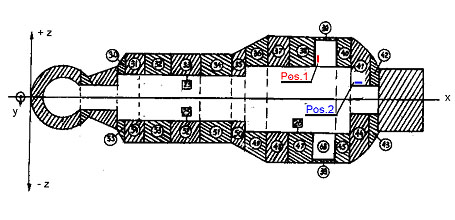
The 6 dosimeter packets were brought on the MIR space station on 8 January 1994. The first phase (ADLET RLF-1) took place from 8 January 1994 to 9 July 1994 and was therefore 182 days long. 2 dosimeter packets (packet no. 09 and no. 10) were returned back to earth. Specialists of both sides evaluated the detectors and a data analysis was carried out.
The experiment’s second phase (ADLET RLF-2) took place from 8 January 1994 to 4 November 1994 and was therefore 300 days long. Both dosimeter packets (no. 12 and 13) were given to the Austrian side in Vienna on 12 December 1994 after the Russian dosimeter was removed.
The third phase of the experiment (ADLET RLF-3) took place from 8 January 1994 to 22 March 1995 (437 days). Both dosimeter packets (no. 11 and 14) were given to the Austrian side in Moscow at the end of March 1995 after the Russian dosimeter was removed.
The assembly and disassembly of the dosimeter packets onboard the MIR space station was carried out by the Russian scientist-cosmonauts in all phases of the ADLET experiment.
Results
The results achieved confirm that the average dose rating absorbed in the occupied area of the space station is very dependent on the location. Furthermore, the different varies by time (exposition period). In the first phase of the experiment, the dose rating of position 1 (minimum shield thickness) varied from position 2 (maximum shield thickness) by a factor of 1.48 (Austrian side) up to 1.59 (Russian side). During phase RLF-2 the variation factor was only 1.27 and 1.2. In phase RLF-3 the absorbed dose varied by a factor of 1.3 measured by both sides. The results of the Austrian and Russian sides agree considerably. The difference of the dose measured during the whole experiment was 3.8% in position 1 and 4.3% in position 2.
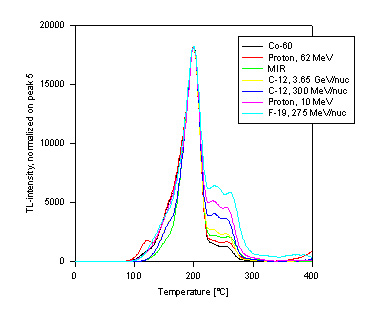
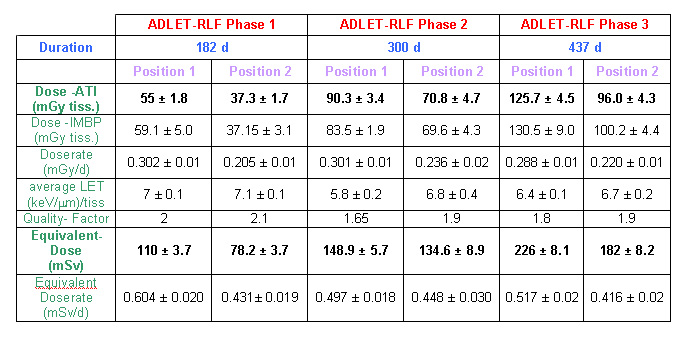
The Russian side carried out measurements of the fluence of heavy laden particles and the LET spectra with core trace detectors CN-85. These results comply with the results achieved earlier.

The Austrian side carried out measures of the fluence of heavy laden particles and LET spectra with a newly developed, semi-automated evaluation system using core trace foils (Makrofol, CR-39). These comply considerably with the results of the Russian side. The core trace films were analyzed by the engineer P. Hofmann as a basis for this thesis.
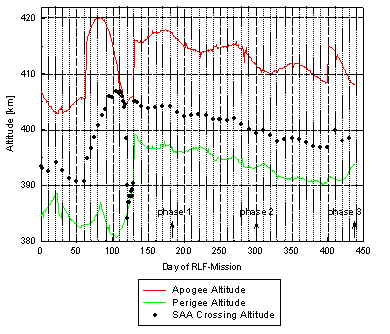
The parameters of MIR’s orbit and the calculated data of the positions’ shielding of the packets 1 and 2 on board the station were used for the interpretation of the results of the ADLET-RLF experiment and for their analysis as compared with other measurements.
In order to interpret the difference of the measurements in position 1 and 2, calculations of the shielding spectra of both measuring positions were carried out by IMBP (Dr. Shurshakov) with the help of a Monte Carlo Simulation. The average shielding value over the total solid angle was 25.9 g/cm2 for pos. 1 and 38.7 g/cm2 for pos. 2. However, the dose difference for these positions is basically limited through the availability of directions with lower shielding (<10 g/cm2) for position 1, whereby the corresponding directions are missing for position 2.
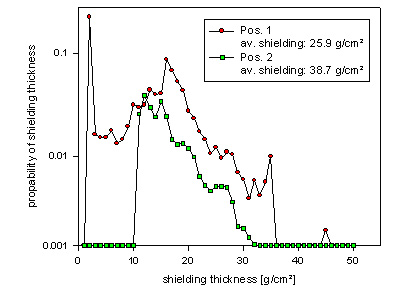
Part of the difference in the mean LET measured in position 1 (lower shielding) and in position 2 (thicker shielding) during the first and second phase of the experiment was most probably conditioned through the higher share of protons. This increased share of dose absorbed is conditioned through the MIR’s passage through the SAA at high altitudes. An analogous effect was observed on the MIR space station during 1988 – 1990 during the execution of the experiments with the LET spectrometer CIRCE.
Technical characteristics
ADLET consisted of the following units
Dosimeter packet ADLET, which was assembled with small thermoluminesence dosemeters (TLD´s) and track films
- Plastic container
- Cloth bag
- from the Austrian side: TLD-100, TLD-600, TLD-700 and a own made LiF-mono-crystal dosemeter (type E, F, I) as well as track films (Makrofol, CR-39)
- from the Russian side: LiF: Ti, Mg- und AL2O3– dosemeter as well as track films (CN-85)
| Mass: | 0.54 kg |
| Dimensions: | 75 mm x 45 mm x 20 mm |
On the actual experiments following Dosemeter packets was involved
Dosimeter packet No. 9 & No. 10
Liftoff on 8 January 1994 with the space transporter Sojuz TM-18
Return transport on 9 July 1994 with the landing machine of the space transporter Sojuz TM-18
Dosimeter packet No. 12 & No. 13
Liftoff on 8 January 1994 with the space transporter Sojuz TM-18
Return transport on 4 November 1994 with the landing machine of the space transporter Sojuz TM-19
Dosimeter packet No. 11 & No. 14
Liftoff on 8 January 1994 with the space transporter Sojuz TM-18
Return transport on 22 March 1995 with the landing machine of the space transporter Sojuz TM-20
Experimenters
Univ.-Prof. Dr. Dipl.-Ing. Norbert Vana (project manager)
Dr. Dipl.-Ing. Wolfgang Schoener
Ing. Manfred Fugger
all: Atom institute of the Austrian Universities, Vienna
Dr. J. A. Akatov
all: IMBP (Institute for Biomedical Problems), Moscow
